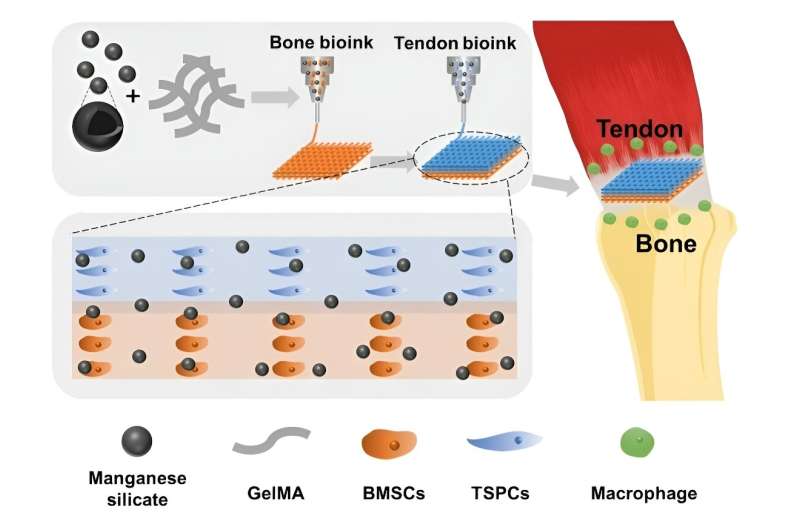This article has been reviewed according to Science X's editorial process and policies. Editors have highlighted the following attributes while ensuring the content's credibility:
fact-checked
trusted source
proofread
Scientists develop new multicellular scaffold strategy for treating tendon-bone injuries

According to a study published in Science Advances, a research group led by Prof. Wu Chengtie from the Shanghai Institute of Ceramics of the Chinese Academy of Sciences has developed a multicellular scaffold based on inorganic bioceramics to achieve immunomodulation and integrated regeneration in tendon-to-bone injuries, i.e., injuries occurring at the tendon–bone interface.
Restriction of motor activity due to loss of natural structure is a major cause of decreased life quality in patients suffering from tendon-to-bone injuries. Conventional biomaterials for the treatment of tendon-to-bone injuries focus on enhancing the regenerative capacity of tendon or bone tissues to promote the restoration of natural structure. However, due to the neglect of the immune environment at the interface and the lack of multi-tissue regenerative function, satisfactory results are still difficult to achieve.
To counter this problem, the researchers combined manganese silicate (MS) nanoparticles with tendon/bone-related cells to construct an immunomodulatory multicellular scaffold using layered cell distribution to achieve integrated tendon-to-bone regeneration.
According to the researchers, integrating biomimetic cell distribution and MS nanoparticles allowed the multicellular scaffolds to simultaneously induce tenogenic differentiation of tendon stem/progenitor cells in the upper layers and osteogenic differentiation of bone marrow mesenchymal stem cells in the lower layers.
Furthermore, rabbit and rat rotator cuff tears treated with the immunomodulatory multicellular scaffolds were simultaneously able to achieve immunomodulation, restoration of interfacial microstructure, and functional recovery.
In addition, the role of immunomodulatory processes in scaffold-specific differentiation was confirmed by implanting the MS nanoparticle multicellular scaffolds into a macrophage-depleted rat model.
The result of the co-culture model with macrophages showed that MS nanoparticles enhanced the specific differentiation of multicellular scaffolds via regulation of macrophages, which was mainly attributed to the secretion of PGE2 factor in macrophages induced by Mn ions.
This research shows that these multicellular scaffolds based on inorganic biomaterials offer a new concept for achieving immunomodulation and integrated regeneration of tendon–bone and other soft/hard tissue interfaces.
More information: Lin Du et al, Immunomodulatory multicellular scaffolds for tendon-to-bone regeneration, Science Advances (2024). DOI: 10.1126/sciadv.adk6610
Provided by Chinese Academy of Sciences





















